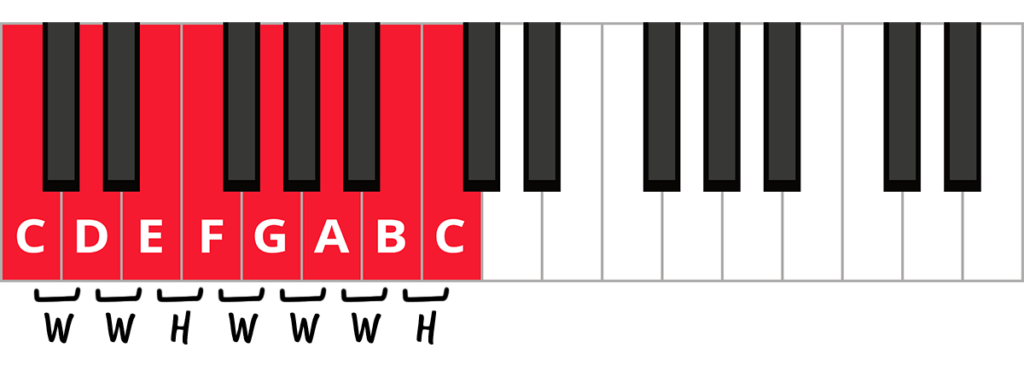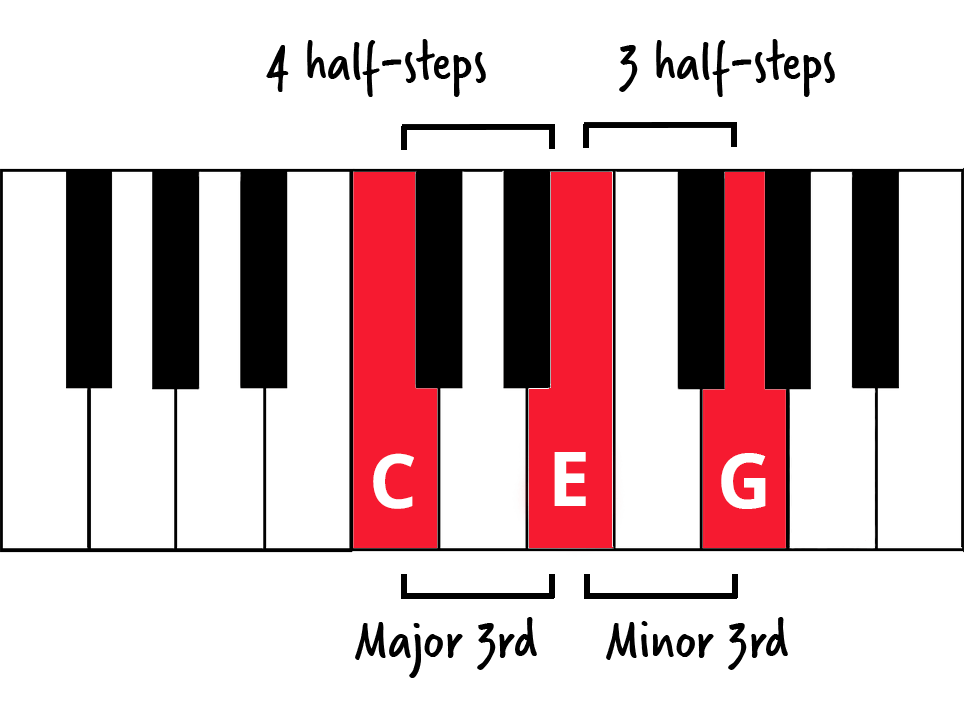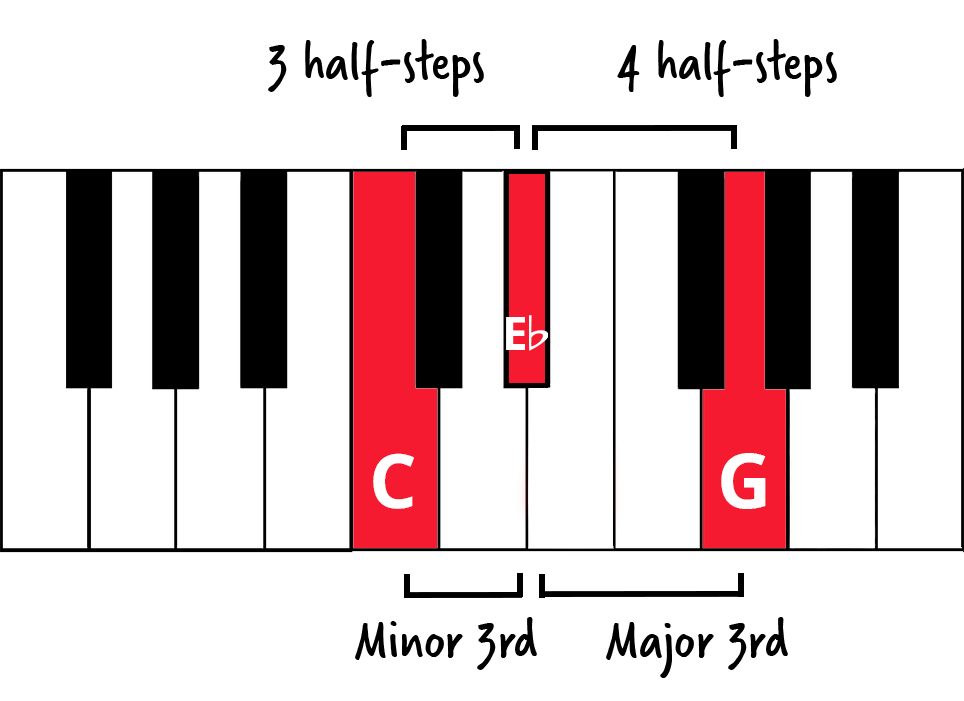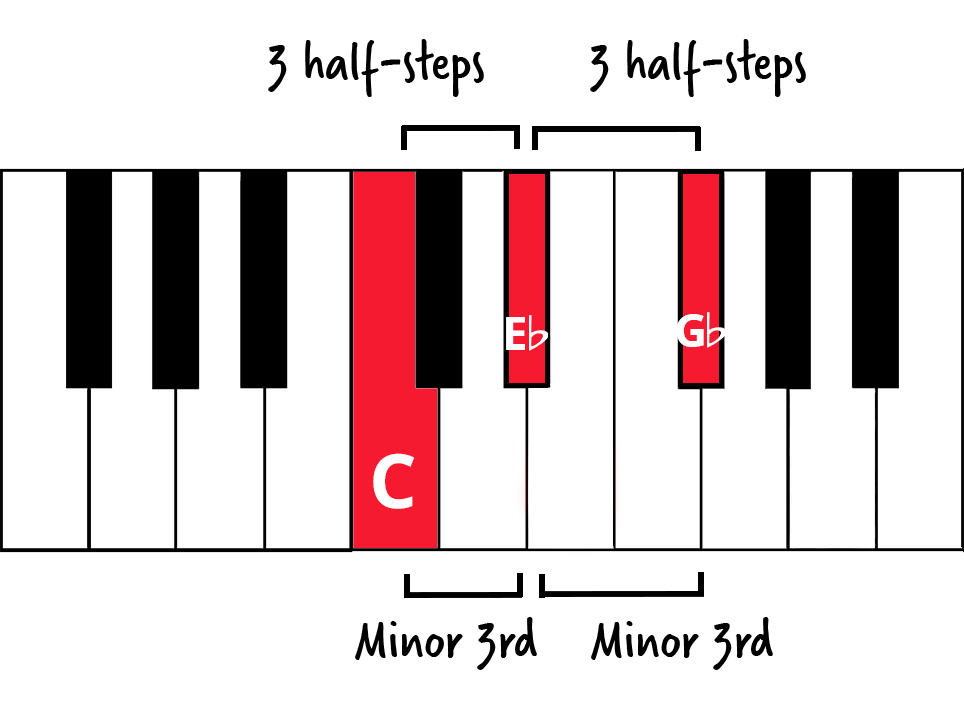Diatonic chords sound fancy, don’t they? Not really! Diatonic chords are really quite simple. In short, a diatonic chord is a chord made up of notes from a particular scale or key.
Not sure what that means? We’ll unpack it in detail 🙂
Table of Contents:
Inspiring tutorials. Fascinating articles. Exclusive interviews. We create piano content anyone, anywhere can enjoy for free. Don’t miss out, sign up for more free lessons.
To understand diatonic chords, we must first understand scales and how they relate to keys.
A scale is a sequence of notes organized by pitch. Often, a formula or set of rules determines how the notes are ordered. For example, this is the C major scale. The major scale formula is a pattern of whole and half-steps.

Many songs use notes that come from the same scale. So, you can think of scales as a “bank” of notes from which to make a song. Songs made of notes plucked from the same scale will naturally sound nice. Of course, musicians don’t always stick to notes from the same scale, but it’s safe to say that in most popular songs, this is what happens.
The key of a song is named after the scale it’s based on. For example, the key of C major gets all of its notes from the C major scale. Similarly, the key of D minor gets all of its notes from the D minor scale.
You can learn more about keys and scales in our Circle of Fifths lesson.
Chords are groups of notes played together. The first chords you’ll learn are three-note chords called major triads and minor triads.
Major triads sound “happy” and they’re made up of a root, third, and fifth. The root is the note the chord is named after. Count up four half-steps and you’ll get your third. Count up another three half-steps and you’ll get your fifth.
If you know your intervals, you can also think of major triads as having a major third interval and perfect fifth interval.

Minor triads sound “sad” and they’re also named after the root note. Count up three half-steps from the root to get your third, then four half-steps to get your fifth.
You can also think of minor triads as having a minor third interval and a perfect fifth interval.

The crunchy diminished triad is another good triad to know. The distance between the root and the third is three half-steps, as is the distance between the third and the fifth.
The diminished triad has a minor third interval and a diminished fifth or augmented fourth interval, also called the tritone.

Root position triads (where the root note is at the bottom) are sometimes nicknamed Snowman Chords because they resemble snowmen on the staff. When you play these triads on the piano, you’ll use fingers 1-3-5, which we like to nickname “the Claw.”
Now that we know how to build scales and how to build triads, let’s put these concepts together and build triads on notes in the scales. This is what diatonic chords are!
So, let’s take C major. Now build a triad on top of each note in C major. You’ll end up with these Snowman Chords:

These are your C major diatonic chords! 🙂
You can also find these chords on your piano by playing the triad claw shape on every note of the C major scale. Like this:
As you move through the notes of the C major scale, these triads will be either major, minor, or diminished.
Interestingly, in all major keys, certain diatonic chords will always be major, minor, or diminished. For example, the second-to-last diatonic chord in a major scale will always be a diminished one.
We’ll go into more detail about this later, but first, let’s quickly run over how to build diatonic triads based on a key with more sharps and flats.
It’s the same procedure as C major: go through each degree of the scale and play the triad shape on top.
The only difference is you need to watch out for what notes to sharp or flat.
So, if you’re working with F major, which has one flat (B), each time you run into B, flat it. Here are all the diatonic chords of F major:

The number system and diatonic chords go hand in hand. In the number system, we assign each note in the scale a number. This is called a scale degree.

Music theorists also have special names for each degree of the scale. You don’t absolutely need to memorize these, but they do make you sound fancy…
| Scale Degree | Name |
|---|---|
| 1 | Tonic |
| 2 | Supertonic |
| 3 | Mediant |
| 4 | Subdominant |
| 5 | Dominant |
| 6 | Submediant |
| 7 | Leading Tone |
Now let’s go back to our diatonic chords and this time, we’ll use Roman numerals. The advantage of using Roman numerals is you can represent major chords with uppercase letters and minor and diminished chords with lowercase letters. (The superscript “o” refers to diminished chords.)

In all major keys, chords I, IV, and V are always major; chords ii, iii, vi are always minor; and the viio is always a diminished chord. You can test this by doing the math for F major:

The number system may look more like math than art, but trust us, there’s a reason we use it!
Numbers allow musicians to seamlessly transpose a song from one key to another. For example, take this chord progression:
C – G – Am – F
This is a common progression in C major, but how do you play this in, say, G major?
Well, if we visualize each chord as a diatonic chord built on a scale degree…
I – V – vi – IV
…we can substitute G major chords based on these numbers!
G – D – Em – C
G is the I chord of G Major. D is the V chord of G Major, and so on.
So…what’s the point to all this theory? Good question!
Diatonic chords help you answer this age old question:
What chords sound good with this song?
If you know all the diatonic chords of a key, you’ll know what chords will sound good in that key! This opens up many possibilities for chording, songwriting, and improvising.
Knowing these chords will also give you a head start in figuring out the chords of a song. Say you’re trying to figure out the chords to a song in D major by ear. By writing or playing out all the diatonic chords in D major, you can narrow down which chords will show up in your song.
We’ve demonstrated how to find diatonic chords in C Major and F Major. Now it’s your turn! See if you can find the diatonic chords in these keys: G major, F major, and B-flat major. Then, find a song you’d like to play in one of these keys and see if you can figure out the chords by ear!
More chording resources:
Subscribe to The Note for exclusive interviews, fascinating articles, and inspiring lessons delivered straight to your inbox. Unsubscribe at any time.
Lisa Witt has been teaching piano for more than 20 years and in that time has helped hundreds of students learn to play the songs they love. Lisa received classical piano training through the Royal Conservatory of Music, but she has since embraced popular music and playing by ear in order to accompany herself and others. Learn more about Lisa.


By signing up you’ll also receive our ongoing free lessons and special offers. Don’t worry, we value your privacy and you can unsubscribe at any time.
We use cookies for traffic data and advertising. Cookie Policy »